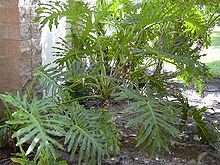Philodendron
| Philodendron | |
|---|---|
 |
|
| Tree Philodendron (Philodendron bipinnatifidum) | |
| Scientific classification | |
| Kingdom: | Plantae |
| (unranked): | Angiosperms |
| (unranked): | Monocots |
| Order: | Alismatales |
| Family: | Araceae |
| Subfamily: | Aroideae |
| Tribe: | Philodendreae |
| Genus: |
Philodendron Schott 1832 |
| Synonyms | |
|
|
Philodendron is a large genus of flowering plants in the Araceae family. As of September 2015[update], the World Checklist of Selected Plant Families accepted 489 species; other sources accept different numbers. Regardless of number of species, the genus is the second-largest member of the Araceae family. Taxonomically, the genus Philodendron is still poorly known, with many undescribed species. Many are grown as ornamental and indoor plants. The name derives from the Greek words philo- or "love, affection" and dendron or "tree". They are commonly called by their generic name.
Compared to other genera of the family Araceae, philodendrons have an extremely diverse array of growth methods. The habits of growth can be epiphytic, hemiepiphytic, or rarely terrestrially. Others can show a combination of these growth habits depending on the environment. Hemiepiphytic philodendrons can be classified into two types: primary and secondary hemiepiphytes. A primary hemiepiphytic philodendron starts life high up in the canopy where the seed initially sprouts. The plant then grows as an epiphyte. Once it has reached a sufficient size and age, it will begin producing aerial roots that grow toward the forest floor. Once they reach the forest floor, nutrients can be obtained directly from the soil. In this manner, the plant's strategy is to obtain light early in its life at the expense of nutrients. Some primary epiphytic species have a symbiotic relationship with ants. In these species, the ants' nest is grown amongst the plant's roots, which help keep the nest together. Philodendrons have extrafloral nectaries, glands that secrete nectar to attract the ants. The philodendron, in turn, obtains nutrients from the surrounding ant nest, and the aggressive nature of the ants serves to protect the plant from other insects which would eat it.
...
Wikipedia
